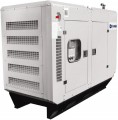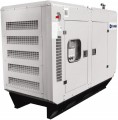Output voltage
Nominal voltage at the generator output.
—
230 V Standard voltage of a regular household socket. It is widely used in everyday life, and there are many 230 V devices among specialized equipment; the only exception is powerful equipment (mainly from 4-5 kW), for which this voltage is no longer enough. It is 230-volt generators that should be considered by tech looking for a device for backup power supply of a residential premises or a small office.
—
400 V Generators capable of delivering three-phase power with a voltage of 400 V. Such power is extremely rarely used in everyday life, but it may be required for heavy equipment, specialized tools and other similar loads. Generators with an output voltage of 400 V are generally more powerful, heavier, larger, more expensive and more "gluttonous" than 230-volt ones. It is worth specifically looking for such a unit only in cases where the presence of three-phase power is essential.
—
230 and 400 V Combined power supply models — most generators with a three-phase output voltage of 400 V are also equipped with single-phase 230 V sockets. This ensures their universal use both for backup power supply of a home or office, and for performing more resource-intensive tasks (for example, in construction and repair, for autonomous operation of high-power loads, etc.).
— 110 V. Generators with 110
...V sockets (or 120 V for certain regions). This voltage is found in household electrical networks in some countries of North and Central America, Japan, Saudi Arabia, and occasionally in Great Britain. It is not recommended to connect 230 V equipment to such sockets (unless otherwise specified in the technical documentation for a specific electrical appliance).
— DC (48 V). Models with one or more DC connectors for powering external devices with direct current. The standard DC socket is round and has a pin in the center, but its depth and diameter may vary. The voltages output to the DC output may vary — in this case, 48 V is implied.Rated power
The nominal power of a generator is the highest power that the unit can supply without problems for an unlimited period of time. In the “weakest” models, this figure is
< 1 kW, in the most powerful ones –
50–100 kW and even
more ; and generators with welding capabilities (see below) usually have a nominal power from
1–2 kW to
8–10 kW.
The main rule of choice in this case is as follows: the nominal power must not be lower than the total power consumption of the entire connected load. Otherwise, the generator will simply not be able to produce enough energy, or will work with overloads. However, to determine the minimum required generator power, it is not enough to simply add up the number of watts indicated in the characteristics of each connected device - the calculation method is somewhat more complicated. Firstly, it should be taken into account that only the active power of various equipment is usually indicated in watts; in addition, many AC electrical appliances consume reactive power ("useless" power consumed by coils and capacitors when working with such power). And the actual load on the generator depends on the total power (active plus reactive), indicated in volt-amperes. There are special coefficients and formulas for its calculation.
The second nuance is related to the power su
...pply of devices in which the starting power (and, accordingly, the power consumption at the moment of switching on) is significantly higher than the nominal one - these are mainly devices with electric motors such as vacuum cleaners, refrigerators, air conditioners, power tools, etc. You can determine the starting power by multiplying the standard power by the so-called starting coefficient. For equipment of the same type, it is more or less the same - for example, 1.2 - 1.3 for most power tools, 2 for a microwave oven, 3.5 for an air conditioner, etc.; more detailed data can be found in special sources. Starting load characteristics are necessary primarily to assess the required maximum generator power (see below) - however, this power is not always given in the characteristics, often the manufacturer indicates only the nominal power of the unit. In such cases, when calculating for equipment with a starting coefficient of more than 1, it is worth using the starting power, not the nominal power.
Also note that if there are several sockets, the specific division of the total power between them may be different. This point should be clarified separately - in particular, for specific types of sockets (for more details, see "230 V sockets", "400 V sockets").Max. power
The maximum power output that the generator can provide.
This power is slightly higher than the nominal (see above), but the maximum performance mode can only be maintained for a very short time - otherwise an overload occurs. Therefore, the practical meaning of this characteristic is mainly to describe the efficiency of the generator when working with increased starting currents.
Let us recall that some types of electrical appliances consume several times more power (and, accordingly, power) at the moment of starting than in the normal mode; this is typical mainly for devices with electric motors, such as power tools, refrigerators, etc. However, increased power for such equipment is needed only for a short time, normal operation is restored in literally a few seconds. And you can estimate the starting characteristics by multiplying the nominal power by the so-called starting coefficient. For equipment of the same type, it is more or less the same (1.2 - 1.3 for most power tools, 2 for a microwave oven, 3.5 for an air conditioner, etc.); more detailed data is available in special sources.
Ideally, the maximum power of the generator should be no less than the total peak power of the connected load - that is, the starting power of equipment with a starting factor greater than 1 plus the rated power of all other equipment. This will minimize the likelihood of overloads.
Motor type
Model name of the engine installed in the generator. Knowing this name, you can, if necessary, find detailed data on the engine and clarify how it meets your requirements. In addition, model data may be needed for some specific tasks, including maintenance and repair.
Note that modern generators are often equipped with
branded engines from famous manufacturers: Honda, John Deere, Mitsubishi, Volvo, etc. Such engines are more expensive than similar units from little-known brands, but this is offset by higher quality and/or solid warranty conditions , and in many cases, the ease of finding spare parts and additional documentation (such as manuals for special maintenance and minor repairs).
Engine size
The working volume of the engine in a gasoline or diesel generator (see "Fuel"). Theoretically, more volume usually means more power, but in fact, everything is not so clear. Firstly, the specific power strongly depends on the type of fuel, and in gasoline units, also on the type of internal combustion engine (see above). Secondly, similar engines of the same power can have different volumes, and there is a practical point here: with the same power, a larger engine consumes more fuel, but by itself it can cost less.
Power
The operating power of the engine installed in the generator. Traditionally stated in horsepower; 1 HP approximately equal to 735 watts.
First of all, the rated power of the generator directly depends on this indicator (see above): in principle, it cannot be higher than the engine power, moreover, part of the engine power is spent on heat, friction and other losses. And the smaller the difference between these capacities, the higher the efficiency of the generator and the more economical it is. However high efficiency affects the cost, but this difference can pay off with regular use due to fuel savings.
Fuel consumption (50% load)
Fuel consumption of a petrol or diesel generator when operating at half power, and for combined models when using petrol (see “Fuel”).
Fuel consumption usually increases with load. However, generator efficiency is not always linear - fuel consumption may vary disproportionately with different loads. In this case, the approximate amount of fuel consumed by the generator when operating at half power (50% of the rated power) is given. Knowing the fuel consumption and tank capacity, you can at least estimate how long one fill-up will last.
Fuel consumption (75% load)
Fuel consumption of the generator at 75% load (75% of the nominal power of the power unit). The amount of fuel consumed is indicated for gasoline and diesel models, as well as units on combined fuel (in this case, gasoline consumption is usually implied).
Since the generator's efficiency is not always linear, fuel consumption may vary disproportionately with different loads. In this case, the amount of fuel consumed by the generator when operating with a load of about 75% of the nominal power is given. Knowing the fuel consumption and tank volume, you can roughly estimate how long one fill will last.
Fuel consumption (100% load)
The amount of fuel consumed by the generator when operating at full power. The parameter is specified for petrol and diesel units (and for models on combined fuel - when using petrol).
In full power mode, the generator consumes maximum fuel. However, such long-term operation is fraught with accelerated wear of the unit components, so generators are rarely loaded to 100%. Nevertheless, the parameter gives an approximate understanding of the expected fuel consumption when used "at full capacity".

